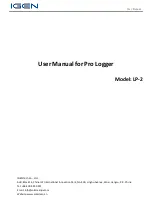
DEWE-43A
TECHNICAL REFERENCE MANUAL
range can not be converted correctly by the sampler. For example, the sample rate is 1000 S/s, the
Nyquist frequency is 500 Hz. If the input signal is a 375 Hz sine wave, the resulting samples represent a
375 Hz sine wave. If a 625 Hz sine wave is sampled, the resulting samples represent a 375 Hz sine wave
too. This happens because signals exceed the Nyquist frequency (500 Hz). The represented frequency of
the sine wave is the absolute value of the difference between the input frequency and the closest
integer multiple of the sampling rate (in this case 1000 Hz).
When the sampler modulates frequencies out of the Nyquist bandwidth back to the 0 to 500 Hz
baseband it is called aliasing. Signals which are not pure sine waves can have many components
(harmonics) above the Nyquist frequency. These harmonics are erroneously aliased back to the
baseband, added to parts of the accurately sampled signal and produces a distorted data set. To block
frequencies out of the Nyquist bandwidth, a lowpass filter is applied to the signal before it reaches the
sampler. Each input channel has its two pole anti-alias lowpass filter with a cutoff frequency of about
250 kHz. The very high cutoff frequency allows an extremely flat frequency response in the bandwidth of
interest and a small phase error. The analog filter precedes the analog sampler. The analog sampler
operates at 256 times the selected sample rate for rates below 51.2 kS/s, 128 times for rates between 51.2
kS/s and 102.4 kS/s. For rates over 102.4 kS/s the oversampling is 64 times. That means, the ADC operates
at 13.1072 MS/s if you select a sample rate of 102.4 kS/s (128 * 102.4 kS/s).
The 1-bit oversampled data is passed to a digital anti-aliasing filter. This filter has no phase error and an
extremely flat frequency response. It also has an extremely sharp roll-off near the cutoff frequency (0.38
to 0.494 times the sample rate) and the rejection above 0.5465 times the sample rate is greater than 92
dB. The output stage of the digital filter resamples higher frequencies to 24-bit samples. The digital filter
passes only signal components within the Nyquist bandwidth or within multiples of the Nyquist
bandwidth of 64, 128 or 256 times (depending on sampling rate). The analog filter rejects most noise
near these multiples. The following diagrams show the frequency response of the input circuitry.
Image 2: Sample rate 0.1kS/s to 51.2kS/s
DEWE-43A V20-2
9/38










































